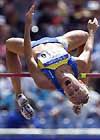Running

Running
events include sprints and long distance races. The
athletes run in lanes on an oval 400m track. The sprint races are
100m,
200m and 400m.
Sprinters
need to be very strong. Distance runners are usually thinner than
sprinters.
The
long distance races are the 800m, the 1500m, the 5000m, the 10, 000 metres
and the marathon.
Hurdles

The
athletes run along a track and jump over the hurdles.
Relays
There
are four runners in a team. Each runner
must run a part of the race while holding a baton which is a short metal
stick.

In the high jump,the athlete who jumps the highest wins. The athlete jumps over a long bar held up in the air by two stands. A big mat is under the bar so the athletes can land safely. The Olympic record is 2.05m for women and 2.39m for men.

In the long
jump, the athlete takes a big run
and jumps into a sandpit A board at the end of the runway marks where the long
jumper must take off. The length of a long jump is measured from the board to the
closest mark in the sand.

Javelins
are like long spears.
The
javelin must land point first otherwise it is not measured.
Throwers cannot use their own javelin.
The same goes for all the throwing events.
Men’s javelin weighs 805 grams and Women’s
weighs 605 grams.

In the shot put he athlete throws from a 2.13m diameter circle. They usually face the back to start and turn before they throw. The weight of the shot is fixed at 7.257 kg for men and 4kg for women. Bent arm throws are not allowed and competitors have to hold the shot in the crook of the neck before they throw.

The
discus weighs 2kg for men and 1kg for
women. The discus
is like a plate. It is made of wood with metal around the edge.
Athletes must stand inside a circle and they spin around to throw the
discus.
The Marathon
The
marathon is the longest Olympic running race.

100m
Marathon
High Jump
Long Jump
Javelin
Discus
9.84sec
2:09.21
2.39m
8.90m
90.17m
69.40
10.62sec
2:23:14
2.05m
7.40m
68.91
72.30